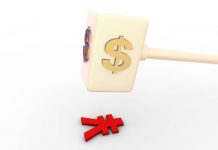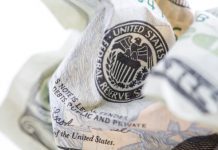- The wave of selling across the tech stocks has reached Europe. The Euro Stoxx 50 index currently hovers around intraday losses of -0.9%. The US stock indexes opened on the same negative sentiment with especially the highly tech-weighted Nasdaq underperforming (-0.36%).
- The first estimate of the American GDP for the second quarter was, with 2.6% Q/Q, lower than the expected 2.7% but significantly higher than the downwardly revised 1.2% in the first quarter. Both consumption (+2.8% Q/Q) and investments (+ 2.0%) contributed strongly. Today’s numbers confirm that the Q1 slowdown was temporary.
- The price data were subdued in the US. The GDP price index declined from 2.0% Q/Q in Q1 to 1.0% in Q2. The consensus had expected a higher reading (1.3%). The same goes for the Employment Cost Index which was 0.5% in Q2, down from a 0.8% number in Q1 and a 0.6% consensus. The core PCE was the only number above expectations (0.9% Q/Q compared to the expected 0.7%).
- GDP readings for Q2 in France, Austria and Spain were all better than expected or they at least matched expectations. In Spain, GDP rose from 0.8% to 0.9% Q/Q and from 3.0% to 3.1% Y/Y (consensus 0.9% M/M and 3.0% Y/Y). France saw its GDP stabilise Q/Q at 0.5% while the Y/Y figure increased from 1.1% to 1.8%, more than the forecasted 1.6%.
- The German CPI surprised to the upside in July with a 0.4% M/M and a 1.5% Y/Y rise (consensus 0.3% M/M and 1.4% Y/Y). In France, the CPI declined an expected 0.4% M/M but stabilised Y/Y at 0.8%. The Spanish CPI declined from a positive 0.1% M/M to a negative 1.2% M/M (consensus -1.3%) but rose from 1.6% Y/Y to 1.7% Y/Y (consensus 1.6%).
- Sentiment among UK households dropped this month to match the weakest reading since just after the Brexit vote, led by a sharp drop in confidence in the economy. The Gfk consumer confidence reading of -12 in July is down two points compared to June and lower than the expected -11.
- The European Commission’s monthly measure of economic confidence nudged up 0.1 points to 111.2 in July – its best level since before the financial crisis hit in 2007. The gauge was driven higher by a bump in confidence in Germany and the Netherlands, but fell back in Italy, France and Spain.
Rates
Core bonds show two faces
Global core bond showed two faces. During the European morning session, the Bund (and US Treasuries) were hard hit by an avalanche of strong activity data and higher than-expected German and Spanish inflation (for July). The Bund fell from about 162.20 to 161.40. Regarding the eco data, French and Spanish Q2 GDP were strong, as was the EC euro area economic sentiment (highest since June 2007). German inflation exceeded expectations and stabilized (HICP) instead of declining. The German curve bear steepened (0.5 to 3.2 bps higher). Intra-EMU 10-yr yield spreads versus Germany were little changed.
The US Treasury followed the Bund lower in sympathy, but limited the losses. During the US session, US Treasuries erased losses on the US economic data, before reverting again a bit lower. US Q2 GDP was near expectations at 2.6%. Q1 GDP was revised marginally lower (see headlines for details). The GDP price indicator, however, slowed sharply to 1% Q/Qa from 2% Q/Qq in Q1 and fell short to expectations (1.3% Q/Qa). Core PCE deflator slowed to 0.9% Q/Qa from 1.8% Q/Qa, beating consensus (0.7%) though. Markets are very sensitive for inflation indicators. After soft CPI inflation, the slowing of the deflators shouldn’t have been a major surprise. However, the soft Employment Cost Index might have been of greater impact on US Treasuries. Wages rose a sluggish 0.5% Q/Q, underlining that the tight labour market isn’t (yet?) triggering wage increases. Without higher wages, the Fed’s hope on fulfilling its target may remain elusive. That also questions the Fed’s gradual tightening campaign. So, US Treasuries erased the losses (bunds barely regained ground), before some selling re-occurred. At the time of writing, US yields are nearly unchanged compared to yesterday’s closing levels.
Currencies
Dollar continues to struggle on soft US price data
The euro initially gained a few ticks on good EMU data today and a declining interest rate differential with the dollar. Euro strength was replaced by USD softness later in the session. US Q2 GDP growth was in line with expectations, but the price data (cost employment indices) were again soft. EUR/USD trades in the 1.1725 area. USD/JPY struggles not to fall below 111.
The decline in equities/rise in volatility in the US spilled over to Asian markets. Losses ranged from roughly 0.5% to about 2%. Japanese household spending was strong and the jobless rate (2.8%) matched the multi-year lows. Japanese inflation held at low levels, close to the 0% mark. There was again little direct impact on the yen. USD/JPY held up quite well given the pick-up in volatility. EUR/USD didn’t show a clear trend and trades in the 1.1680 area.
European data (French and Spanish GDP, EC confidence data and German inflation) were mostly strong (or at least better than expected). There was no one-on-one relation between the data and EUR/USD. Short-term interest rate differentials were little changed. LT European yields rose throughout the session and differentials narrowed in favour of the euro. EUR/USD returned gradually north of 1.17. USD/JPY hovered in a tight range mostly in the 111 area (even as equities remained in the defensive). So, the intraday rise of EUR/USD was at least partially due to euro strength.
EUR/USD rose further ahead of the publication of the US Q1 GDP. However, looking at other USD cross rates, this was more USD softness. US Q2 GDP was very close to expectations (2.6% Q/Qa). The price data in the report were mixed, but a low employment cost index was another indication of slow wage growth. US yields and the dollar declined. EUR/USD reacted most. EUR/USD spiked to the mid 1.17 area, but trades again in the 1.1730/35 area. The test of the 1.1714/35 barrier continues. The loss of USD/JPY was more modest. The pair tries not to fall below 111.00. The conclusion from the previous days hasn’t changed: sentiment on the dollar will probably remain fragile unless there comes good news from prices and even more from US wages.
Sterling rebound stalls as global uncertainty weighs
GFK consumer confidence was marginally softer than expected overnight. There were no other important eco data in the UK today. Of late, the UK currency tried to regain ground against the euro. EUR/GBP slipped temporary below 0.89. However, the move had no strong legs. The rise in overall volatility yesterday and this morning weighted on sterling. Good EMU data, rising EMU yields and a rebound in EUR/USD, pushed EUR/GBP higher. There were also some, albeit second tier, headlines confirming stubborn hurdles in the Brexit negotiations (UK exit bill, Irish border…). The 0.8995 correction top looms again on the horizon. EUR/GBP trades currently in the 0.8970 area. Cable trades near 1.3080.












